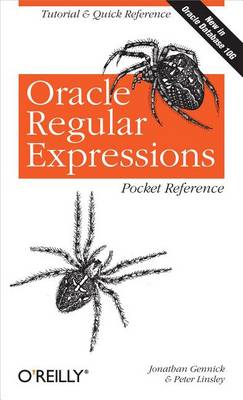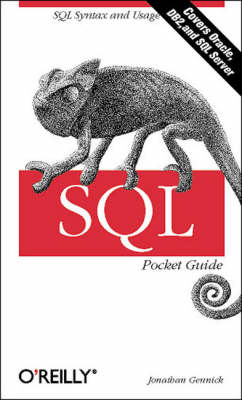Pocket Reference (O'Reilly)
4 total works
Oracle Regular Expressions Pocket Reference
by Jonathan Gennick and Peter Linsley
Published 1 January 2003
Oracle has long supported the ANSI-standard LIKE predicate for rudimentary pattern matching, but regular expressions take pattern matching to a new level. They provide a powerful way to select data that matches a pattern, as well as to manipulate, rearrange, and change that data. This concise pocket guide is part tutorial and part quick-reference. It's suitable for those who have never used regular expressions before, as well as those who have experience with Perl and other languages supporting regular expressions. The book describes Oracle Database 10G's support for regular expressions, including globalization support and differences between Perl's syntax and the POSIX syntax supported by Oracle 10G. It also provides a comprehensive reference, including examples, to all supported regular expression operators, functions, and error messages.
SQL (Standard Query Language) is the universal standard when it comes to querying and updating databases. It's also rich and complex, with so many features that even the most experienced programmers only make use of a small percentage of them. Why is that? Well naturally, when you're deep into your work, you want to avoid distractions. And it's easy to get distracted when you pull your favorite reference book off the shelf. Your solution is the SQL Pocket Guide--a seamless, fast syntax lookup that won't divert you from the task at hand. Concise and easy-to-use, this little book is the portable companion to O'Reilly's SQL in a Nutshell. This unique reference can be a major help to programmers who use SQL in their day-to-day work. Not just an endless collection of syntax diagrams, this small guide addresses the language's complexity head on and leads by example. If you need to look up the syntax for a particular statement, you'll find helpful examples of the technique. You can then combine several techniques for your own SQL statements. The book covers the three most commonly used database products: Oracle, IBM's DB2, and Microsoft's SQL Server.
It's a concise reference to frequently used SQL statements and commonly used SQL functions. The SQL Pocket Guide is written for programmers and database administrators who are already familiar with SQL (Structured Query Language) but want to utilize more of the language's features and syntax than they typically do. The book is small enough to always keep close by, and concise enough that you can look up the syntax you need quickly without having to wade through a lot of text. O'Reilly's Pocket References and Guides have become a favorite among programmers everywhere. By providing a wealth of important details in a succinct, well-organized format, these handy books deliver just what you need when you're hard at work. When you've reached a sticking point and need to get to a solution quickly, the new SQL Pocket Guide is the book you'll want to have.
It's a concise reference to frequently used SQL statements and commonly used SQL functions. The SQL Pocket Guide is written for programmers and database administrators who are already familiar with SQL (Structured Query Language) but want to utilize more of the language's features and syntax than they typically do. The book is small enough to always keep close by, and concise enough that you can look up the syntax you need quickly without having to wade through a lot of text. O'Reilly's Pocket References and Guides have become a favorite among programmers everywhere. By providing a wealth of important details in a succinct, well-organized format, these handy books deliver just what you need when you're hard at work. When you've reached a sticking point and need to get to a solution quickly, the new SQL Pocket Guide is the book you'll want to have.
This pocket reference offers reference information that should help you use SQL Plus, Oracle's interactive query tool. It summarizes all of the SQL Plus syntax, including the syntax for new Oracle8i release 8.1.6 features. It describes interacting with SQL Plus, selecting data, formatting reports with SQL Plus, and tuning SQL queries. It also contains quick references to the SQL Plus commands and format elements.


